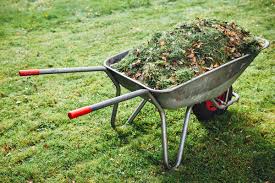 Yard waste is one of the most annoying things to deal with when it comes to lawn care. It costs a lot to dispose of, it takes nutrients from the soil, and it can be an environmental hazard. However, with good management practices, you can address all three of these issues, saving time and money.
Yard waste is one of the most annoying things to deal with when it comes to lawn care. It costs a lot to dispose of, it takes nutrients from the soil, and it can be an environmental hazard. However, with good management practices, you can address all three of these issues, saving time and money.
Why is Yard Waste an Environmental Hazard?
Why is your local government on to homeowners to manage their lawn waste? It goes far beyond being neat and tidy. Unless the yard you’re working on is in the country, leaves and grass clippings that come off of a lawn will eventually make their way into drainage systems. From there, they enter waterways, adding organic material from dead plants and nutrients from fertilizer. Algae thrive on this material, causing blooms that block light and reduce the oxygen content in the water. This can kill fish and make water so toxic that recreational areas have to be closed off to protect people from being poisoned.
That waste is taking valuable nutrients with it, which means you need to do more work and use more fertilizer to compensate. Good management practices don’t just protect the environment, they make it easier to maintain your lawn.
Getting Waste Back Into the Soil
The simplest way to keep nutrients in the soil is through mulching. By chopping up leaves and grass clippings, it’s easier for microorganisms to digest them. Better still, this boosts microorganism activity, which speeds up the breakdown of woody plant debris that makes up mulch.
Mulching alone isn’t always the solution for yard waste. If grass height or leaf buildup results in piles of debris laying on top of the lawn after mowing, it’s time to choose alternate disposal methods. That’s when it’s time to use a lawn vacuum. Clippings are cut down by the vacuum’s impeller and bagged automatically. Since yard waste is priced by the bag, this compaction reduces the total cost of disposal. However, the collected waste doesn’t have to be thrown out. Building a compost pile can digest waste on-site, saving money and turning that waste into something that can be returned to the lawn. Even natural herbicides found in plants like black walnut trees will break down after a few weeks, making the mulch safe to use.
If you decide to dispose of your lawn debris instead, it shouldn’t go into a landfill. Most areas have seasonal debris pickup, funneling this waste to large compost facilities. Debris will break down in a landfill, but since it’s covered, this happens through anaerobic (oxygen-free) digestion. The resulting methane is a powerful greenhouse gas, and it’s extremely flammable. This makes it a hazard for waste management workers.
Composting: Not as Hard or Stinky as You Think
There’s one big difference between compost piles made of yard wastes and those made from garbage: smell. A pile made mostly of lawn debris won’t stink as it breaks down. Lawn clippings and leaves also have the advantage of containing a mix of “green” and “brown” materials. The combination of dry and moist materials is ideal for encouraging microbe growth.
The material you put in the pile needs to be in fine pieces. If you gathered lawn debris in a vacuum, or you picked them up with a truck loader, the impeller does this for you. This pile should be in the shade or covered by a tarp. Wet down the pile each time you add organic material. Stirring the pile every couple of weeks speeds up the breakdown process. Don’t be surprised if the pile is warm. When microbes are active, they can raise the center of the pile to temperatures as high as 140 degrees F.
After a couple of months, you should start to see what looks like dark soil. This is humus. This material can be used for top dressing on lawns or to boost the nutrients in your garden. It has a medium texture, so mixing it with clay soils improves drainage while mixing it with sandy soils improves structure.
Get the Most from Your Billy Goat Equipment
Billy Goat Parts is an authorized dealer for Billy Goat as well as their manufacturing partners, including Honda, Briggs & Stratton and Tuff Torq. That means we have the parts and accessories you need to keep your lawn vacuums, debris loaders, and vacuums running. Visit us at www.billygoatparts.com. We have sections for common replacement parts, and our search engine can find parts based on your model and serial number. We even have factory diagrams and descriptions built into our site, so you can be sure you’re ordering exactly what you need. We can ship your order to any address in the U.S. or Canada.
